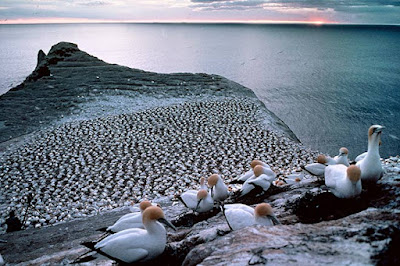NEW ZEALAND, AUSSIE BIRDS, SOME BATTLING EXTINCTION, RANK HIGH ON 'MUST-SEE' LIST
 |
| This friendly gull is waiting for the appetizer, not the fake wine, with Sydney Bridge and Harbour behind him and a patient Bruce Keller. |
HAVE YOU ever looked a kakapo in the eye in the middle of the night? Or watched an ibis vie for your fish and chips at an outdoor cafe?
Birds are so much a part of daily life in Australia and New Zealand that residents give scarcely a glance to feathered friends exotic to us. After widespread bird extinction, the abundance and "come back" seems ironic.
Today's flightless birds include showy ostriches, emus, kiwis and other winged non-flyers. They're called ratites.
 |
| At a Sydney cafe, this ibis caught our eye. Other diners didn't notice. |
 |
| The kakapo or night parrot has alluring beauty and is making a comeback from near extinction. |
 |
| A tern on New Zealand's south island near Milford Sound. |
ANOTHER OF our favorite southern hemisphere birds can fly, as we witnessed.
The beautiful Australian white ibis is as common Down Under as is our North American pigeon. Folks call them "bin chickens."
 |
| Gannets in New Zealand's Muriwai Park are protected. |
We watched them at outdoor cafes -- as people shooed them with newspapers, sometimes smiling at their beauty, sometimes not.
We observed a mating pair for a couple hours, while we munched on fish and chips. They swooped in on a next-door table's remains with the confidence of seagulls in our San Diego coastal parks.
 |
| Maori hunted birds, eating their meat and using their feathers for capes. They pay homage to feathered friends in this Okains Bay Maori Museum. |
 |
| This red billed swan enjoyed a swim in Melbourne's Yarra River. |
 |
| Fiordland's colorful crested penguins often mate for life. |
THE IBIS HAVE an elaborate courtship and nesting ritual -- almost dance like -- involving bowing to show off white plumage and black head and neck. The female plays hard to get, but finally gives in. The male finds twigs and she builds the nest. In flight, flocks of Australian white ibis form distinctive V-shaped flight patterns, much like our Canada geese.
Click here for art, music, film and theater at Lilianslastdance.com
The Southern Hemisphere is also known for its fabulous gannet colony in Muriwai. Thousands of these graceful birds nest in the crags and cliffs north of Auckland and are protected by the New Zealand government. We also viewed that famous black and white flightless bird -- the penguin. Mainly residing in the Antarctic, penguins migrate to the southern tips of Australia and New Zealand. We love knowing that the handsome Fiordland crested penguin is monogamous and mates for life!
DUNEDIN DELIGHTS: Coming next Wednesday, we visit Dunedin, one of New Zealand's charming cities. Delightful Dunedin, settled by the Scots in 1848, is known for its remarkable train station. Remember to explore, learn and live and tell your friends about www.whereiscookie.com
where you'll find pieces on travel, adventure, hotels and cruising.
For theater, books, film and the arts, check us out at our new blog: www.lilianslastdance.com
Click here for art, music, film and theater at Lilianslastdance.com
The Southern Hemisphere is also known for its fabulous gannet colony in Muriwai. Thousands of these graceful birds nest in the crags and cliffs north of Auckland and are protected by the New Zealand government. We also viewed that famous black and white flightless bird -- the penguin. Mainly residing in the Antarctic, penguins migrate to the southern tips of Australia and New Zealand. We love knowing that the handsome Fiordland crested penguin is monogamous and mates for life!
 |
| The Dunedin Train Station is the second most photographed landmark in the Southern Hemisphere, behind the world famous Sydney Opera House in Australia. |
DUNEDIN DELIGHTS: Coming next Wednesday, we visit Dunedin, one of New Zealand's charming cities. Delightful Dunedin, settled by the Scots in 1848, is known for its remarkable train station. Remember to explore, learn and live and tell your friends about www.whereiscookie.com
where you'll find pieces on travel, adventure, hotels and cruising.
For theater, books, film and the arts, check us out at our new blog: www.lilianslastdance.com


No comments:
Post a Comment